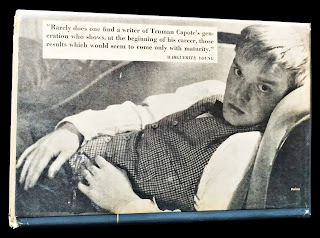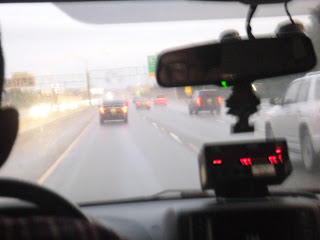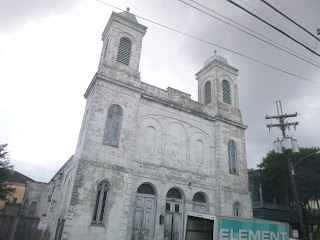Nola, “casual frontiers,” and the Circle.
I hear the trains in the distance, sunlight peaking out through the clouds, streetcars carrying people to a favorite restaurant, storms in the distance, beyond the morning sunlight. For now, the view from our balcony on Royal Street feels like Puerto Rico, hot, humid, palm trees in the distance. That was the feeling waking on Saturday, after our long journey into New Orleans. We arrived at 7 PM, the night before, after a detour by way of New Jersey from our house in Brooklyn. “Wrong airport,” says security, sending us back back Queens, by way of a rushed cab. We still got there early, into the sky, off through the clouds, giggling to Confederacy of Dunces, straight into the clouds, on our way to Babylon on the Mississippi. Post storm sunlight peeks through the clouds when we arrive, the sun descending in the distance, a warm greeting from the open sky.
There’d be a lot of giggling throughout the weekend.
First stop is Galatoire's on Bourbon Street, as always, dinner with my teenage traveling companion. Like Ignatius in the Confederacy novel, "studying the crowd of people for signs of bad taste in dress” the ever weary teenager looks about, taking in the heat and the characters. It's a little formal for them, the streets about it, a little tacky. Still, there’s plenty to share. We talk about Dad and our countless journeys here through the years, stops between Bridgeboro and Dallas, or conferences and a last trip to Florida.
And the conversation turns to stories of girlfriends and muses.
I tell them about a Goth vampire I dated years and years ago.
“I should add more on them in the next novella,” I gushed.
“Don’t just let them just be a pixie dream girl,” they followed.
“What's that?”
“The young women who show the male protagonist the way to understanding life.”
“She wasn’t just a muse, we laughed and laughed together,” I replied, our whole lives, each year in summer school. And then as soon as she arrived, she disappeared. She moved to New Orleans and sent me a final card announcing she was leaving town to join a traveling Shakespeare company. I never heard from her again. There’d be a lot of ghosts along the way, moving amongst us, and disappearing under the gas lamps along Royal Street.
“Good evening gents,” said our amicable waiter as we left.
The teenager’s older sister and joined me the last few trips. This would be our fist, a vision quest, journeying through the city and its consciousness, across neighborhoods, once Spanish, French, Cajun, a little Caribbean, others Creole, flavors abounding, mixing, meshing, blending, the sounds of marching bands in the distance.
Down the street we walk after dinner, from Bourbon to Hotel Monteleone to 711 Royal Street, where Truman Capote finished other voices other rooms. Theres plenty of Southern Gothic History to unpack, I think. Truman’s story began with a walk through the woods in Monroeville, Alabama, three hours from Columbus, where Mom and Carson grew up. Like Mom and Carson, it was a little small for Truman; he escaped the claustrophobia of Alabama for a Greyhound ticket out West. Truman made it as far as New Orleans. Once here, he found something in the open spaces, open minds. On Royal Street, he rented a room, where he could write all night, with no parents or family about to be concerned with his night owl ways. “Noisy as a steel mill,” he recalled that creative flourish of January 1945. “Streetcars clattered and tourists chattered outside during the day,” wrote his biographer Gerald Clark. “At night sailors and soldiers turned the street into a raucous party…. He worked steadily… [and] looked at the months in the French Quarter as ‘the freest time” of his “ life. ‘I had no commitments to anyone or anybody.” recalled Truman, before moving North finding a home on a yellow brick house on Willow Street in Brooklyn Heights. There, he made friends with Carson McCullers, who’d arrived by way of Columbus, Ga.
“Next to music, beer was best,” wrote McCullers in The Heart Is a Lonely Hunter.
There was plenty to unpack between the two.
“...love is a joint experience between two persons,” said Carson. “but the fact that it is a joint experience does not mean that it is a similar experience to the two people involved… these two come from different countries…”
I guess we all do, I thought as we made it past the gas lamps on Bourbon Street, past old spirits in the night.
Down Royal, we walked, up and around past Pirates Alley where Faulkner wrote Soldiers' Pay, and Rob drank absinthe in my favorite short story of his, down to Jackson Square. On we made our way to the Marigny, a district of bistros, bars and jazz clubs, with a history of freed former slaves, mixing with new immigrants, and writers, residents Capote to Whitman. And down we walked to our guesthouse.
In New Orleans, A Writer's City TP Johnson suggests Royal is “the most iconic thoroughfare of the city’s literary history,” (p. 3). The literary history of the city reveals itself, neighborhood by neighborhood, starting here. “Streets are themselves passages,” writes Johnson, “with conflicting meaning that one must learn to navigate, and, in the broadest sense, to read. Quintessentially public spaces, streets are monuments … they divide one neighborhood from another, but also connect them, as much bridge as border… their identity remains always fluid, a function of the people, moment to moment, who happen to be hanging out or racing along… they merge history and geography, time and space, crystalizing… an array of competing meanings.” These meanings and flavors are part of why we come. “Thus, the legendary mystique of these New Orleans streets, their peculiar haughtiness and allure.”
Birds are chipping outside our room on Royal Street in the morning. With coffee in hand, we take it all in before making our way back to the street. First stop, Flora Cafe, full of flyers for banjo lessons, a note asking about vampire novels, quirky artwork from local artisans, a surrealist art show, old books, and a piano Jesse played when he came here with Dodi three years ago. A breakfast burrito and carrot cake was enough to get us started, taking it all in in one of the coolest cafes in America.
“Do you know which way is Dauphine,” we ask a man with dreadlocks outside after breakfast.
“Which way are you going?”
“Dauphine and Desire,” I reply. He points, without blinking at the poetry of the street names.
Down to Dauphine we walk to Desire, to Freddy’s One Stop, an old breakfast spot and store, just off Piety Street. Its closed so we move toward the waterfront, past Vaughn’s Lounge, where Kermit used to play Thursdays, crossing an old railroad track, taking in the Plessy v. Ferguson Historical Marker 700 Homer Plessy Way. And walk down to the end of the End of the World, a decommissioned Navy base, turned squat and temporary autonomous zone. When temporary autonomous zones are discovered, they generally shuttered. That was Hakim Bey’s point in the TAZ. And it certainly appears to have happened here. Fights, someone shot, and authorities were called in. One car honked when we crossed no trespassing sign. Another pulled up ominously, with a glare and a gun, and waving us off.
“Lets get out of here,” we booked. Violence is always below the surface here. No need to dig too far. Or look for it. This wasn’t trouble we were looking for.
In need of a break, we stop at coffee shop.
“Is this your dad,” says the amicable barista to the teenager.
“He’s cute.”
They smile, the teenager blushing.
We sit outside.
Some hipsters are there. We find ourselves, eavesdropping on a woman telling stories about her adventures in polyamory, .meeting the love of her life, feeling many orgasms before he dumped her. It goes on for a half hour very tragic, story after story. Lots of giggles.
“What else are we doing Dad?” they ask.
“We’ve done most everything I usually do here in a day and its just 1130 AM.”
Between thrift shops and the heat, we need a break.
The teenager walks us to visit a friend on St Roch, not far from the Bywater District.
I stop at the St Roch Tavern next door, finding respite from the storm, in the dive bar full of desultory characters playing cards, their patron saint known for championing “dogs, invalids, falsely accused people, bachelors…” Seems appropriate. The storms finally comes.
Rains all afternoon. People chat, dropping in, leaving, perusing the mutual aid corner.
James calls from Brussels.
And the conversation meanders into the afternoon, as the rain ends.
The teenager returns from an afternoon of looking at zines, talking about sometimes a great notion, and DiY possibilities with old friends, from a wondrous summer a few years prior, when everything changed. “...there is always a sanctuary more,” says Ken Kesey in his 1964 homage to freedom, “a door that can never be forced, a last inviolable stronghold that can never be taken, whatever the attack…” Still feels apt. Each year a different struggle and stronghold. I recall them listening to podcasts, painting portraits, and turning inward during the pandemic first year of high school, a crazed second year running up to Lincoln Center, writing stories, watching friends struggle to hold on, watching the “Needle in the Hay” the Richie suicide scene in Royal Tenenbaums over and over again. Seems to lift David Foster Wallace in Infinite Jest. And then off to Berlin for junior year, looking for something out the window on trains from East to West, back to Brooklyn for a final year of high school, full of college essays, road trips to old cemeteries, mosh pits, a respite in between haircuts, searching for the next novel to read, guides to ways of being in the world.
And the two of us walk off to Coop’s, a dive bar serving neighborhood favorites on Decatur, where we hung out with Dad’s ashes a decade ago. “Congrats,” says the bartender, reviewing their ID. And order some for some gumbo, red beans and rice and a veggie burger. We talk about life, growing up, the books they love, the trials up that tests us all. Earlier in the week, I had a dream about them hiking and leaping across a divide, between this life and that, this stage of life and the next. Hurling across, they find something to grab, holding as they make their way forward. We talk into the night, taking in thrift stores, looking at the squatters and crusties at Elysian Fields and Decatur, many out to Portland, cooler climes than this. Off to see some thrasher bands, our driver tells us stories about his life before and after the storm. The afternoon’s rain felt a like a reminder, he tells us. The rains came, pouring on the streets below, shutting the city. Where are you from? New Orleans in the future josh used to say, by way of Brooklyn. 19 years ago we were here the week before the storm. This year I'm with the teenager, his grandchild, exploring the city still recovering, 50 percent below sea level, still alive, on the precipice.
There is a Robin red breast outside the balcony, chirping away the next morning.
The visionquest begins with breakfast at Cafe Flora, more carrot cake coffee and bean and egg burritos, flipping through the zines. I peruse the editorial in the new Antigravity, “... it always feels, unfucking believable. Much like the legendary local lords, EYEHATEGOD, we were not supposed to last this long…” The project was just about flooded in by Katrina, like much of the city.
“I love EYEHATEGOD,” says the teenager, taking a snapshot of themselves on the camera.
We look at the surreal paintings on the wall, wondering if there is room for another chapter.
The teenager sees them with their own critical eye.
Finishing breakfast, we amble up the Esplinade past Rampart through Treme uptown on a two-mile walk to St Louis Cemeteries # 1 and 2. By way of background... "In 1820, the City Council, following the belief that the contagions of yellow fever, cholera and other pestilential diseases were spread by “miasmas” emanating from cemeteries, wanted to find a new site for a cemetery farther removed from the center of population.” According to “ miasma theory… diseases—such as cholera, chlamydia, or the Black Death—were caused by…noxious form[s] of "bad air", also known as night air.” As result, “The Council insisted on locating a new cemetery at least 2,400 feet from the city limits and the nearest practical site, on what is now Claiborne Avenue, was only 1,800 feet from Rampart Street… The city deeded it to the wardens of the Cathedral…. The church consecrated it for burials in August 1823… the cemetery is… one continuous piece of property running from Canal to St. Louis Streets. The division into squares was done when Iberville, Bienville, Conti and St. Louis Streets were cut through. Notable tombs include: Musicians Danny Barker and Ernie K. Doe as well as Andre Cailloux (1825-1863), African-American Union hero and martyr of the American Civil War."
Taking in the above ground tombs and graves, many crumbling in disrepair, a security guard runs up to us to tell us we can’t be there. I think he wants to send us to the St Louis number one where they are charging people to see the graves. I tell him my uncle Louis is here. Uncle Louis, he laughs. Doesn’t matter. Just a quick walkthrough. We’re having fun.
Our journey takes us back down back through the summer heat down St Claude. I’ve now sweat through my shirt. We stop for some slushies. I immediately have a brain coma. Blue tongues are with us all afternoon. And they are off to play banjos with buddies. I make it down to Frenchman Street for Jazz sets all afternoon. And they meet me later in the afternoon, perusing the stacks of records and banjo supplies at Louisiana Music Factory. I hope I’m just as fun as my sister, they say, feeling uncertain. Come on I reply. We chat with the other one in Berlin. And stop for a set with the Treme Brass Band at DBA. “Shake an bake” and greetings sings their amicable leader, “you are off for a wondrous journey,” the band regaling us with stories about friends as wide as the Mississippi, greeting the little kids at the show, welcoming them. I'm recalling my early trips here, Dad telling me that's a bit of church when a trumpet player opened up for us, full cycle, the sound of trombone and tubas fly in my ear.
We leave after one set, strolling back up Decatur Street, past the Abby, with its iconic jukebox and quirky French Quarter vibe. Finally, we stop for crawfish at Turtle Bay, where we share stories and try to unpack the message of a Confederacy of Dunces... and its eternal philosophy, "we see that even when Fortuna spins us downward, the wheel sometimes halts for a moment and we find ourselves in a good, small cycle within the larger bad cycle.”
It's a good lesson for a father and their kid, who have good circles, around some not-so-positive moments, the teenager breaking away, ‘small cycle within the larger cycle,” each circle, circling around the other, bringing us here, sharing crawfish and corn, drinking beer, just as I did with my dad in New Orleans.
And we journey home. I’m finishing, Confederacy of Dunces, the teenager completing As I Walked Out One Midsummer Morning, a story about a British hiker who left home only to stumble into the Spanish Civil War, finding the world: “I could go anywhere I liked in the world. There was nothing to stop me, I would be penniless, free, and could just pack up and walk away. I was a young man whose time coincided with the last years of peace, and so was perhaps luckier than any generation since. Europe at least was wide open, a place of casual frontiers, few questions and almost no travelers.”
As the planes landing, I read of the last lines of Dunces:
“Now Fortuna had saved him from one cycle, where would she spin him now?”
None of us knew.
Back home, I sit on the couch, thinking about it all, jotting down a few notes.
Words from the band on Frenchman Street, still dance in my head:
“Do you know what it means to miss New Orleans
Miss them moss covered vines the tall sugar pines
Where mockin' birds used to sing
And I'd like to see that lazy Mississippi hurryin' into spring
The moonlight on the bayou a creole tune that fills the air
I dream about magnolias in bloom and I'm wishin' I was there.”
I did miss those, “moss covered vines…” and “ magnolias in bloom.”


















































































































































































No comments:
Post a Comment